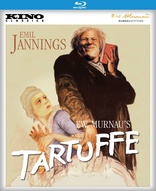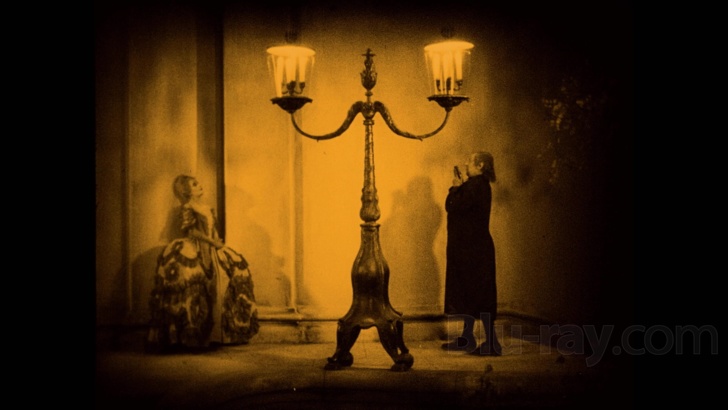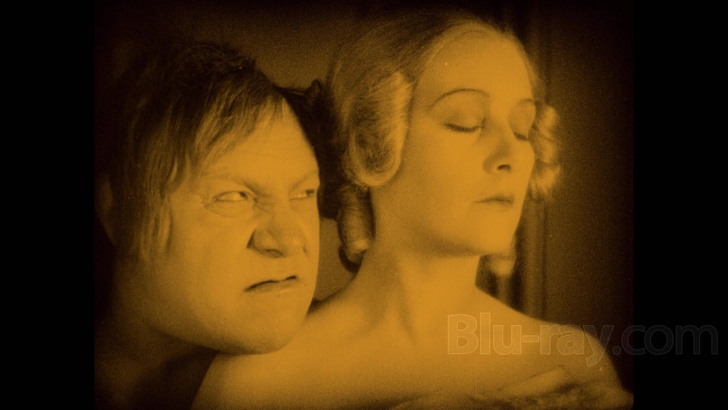Tartuffe Blu-ray Movie
HomeTartuffe Blu-ray Movie 
Herr TartüffKino Lorber | 1925 | 74 min | Not rated | Apr 28, 2020

Movie rating
6.9 | / 10 |
Blu-ray rating
| Users | 0.0 | |
| Reviewer | 3.5 | |
| Overall | 3.5 |
Overview
Tartuffe (1925)
A young man shows his millionaire grandfather a film based on Molière's Tartuffe, in order to expose the old man's hypocritical governess who covets his own inheritance.
Starring: Hermann Picha, Rosa Valetti, Werner Krauss, Lil Dagover, Emil JanningsDirector: F.W. Murnau
| Foreign | 100% |
| Drama | 75% |
Specifications
Video
Video codec: MPEG-4 AVC
Video resolution: 1080p
Aspect ratio: 1.33:1
Original aspect ratio: 1.33:1
Audio
Music: DTS-HD Master Audio 5.1
Music: LPCM 2.0 (48kHz, 16-bit)
Subtitles
English
Discs
Blu-ray Disc
Single disc (1 BD)
Playback
Region A (B, C untested)
Review
Rating summary
| Movie | 4.0 | |
| Video | 4.0 | |
| Audio | 3.5 | |
| Extras | 2.5 | |
| Overall | 3.5 |
Tartuffe Blu-ray Movie Review
Reviewed by Dr. Stephen Larson October 21, 2020Tartuffe was made in the midst of a halcyon period for German auteur F.W. Murnau. Because it was released in between The Last Laugh (1924) and Faust (1926), it's often been overshadowed by those two masterpieces. It was intended as a star vehicle for Emil Jannings, who was under contract at UFA studios and a big box-office draw. Famed producer Erich Pommer was really the instigator for the project as was Carl Mayer, who adapted Molière's 1664 play for the screen. Although Murnau was brought in later, Tartuffe has all the earmarks of the director's characteristic use of Expressionistic light and shadows.
Irene Thirer, a reviewer for the Daily (NY) News, noted in 1927 that Mayer and Murnau added a prologue and epilogue since the picture couldn’t be stretched to seven reels. These book-ended sections were not part of the play and while American critics welcomed the additions, the Brits scoffed at them probably because they wanted to see the quintessence of Molière's version preserved. The modern story sees an avaricious housekeeper (Rosa Valetti) plot to steal the fortune of her employer, an elderly man (Hermann Picha). The housekeeper tries to sway the old man into transferring his inheritance over to her rather than his grandson (André Mattoni). The grandson arrives to greet his grandfather but the housekeeper refuses him entry and when he eventually sees him, he's sent away. The grandson disguises himself as a travelling cinema exhibitor and screens the story of Tartuffe for his grandfather and the housekeeper.
Murnau employs the play within the film device with ingenuity. Tartuffe (Emil Jannings) is the guest of honor at the Schloss of Herr Orgon (Werner Krauss), a nobleman and wealthy patron. Tartuffe self-proclaims he's a pious fellow and saint. He chides Orgon for wearing a ring but he's much more materialistic than he projects. He flirts with Elmire (Lil Dagover), Orgon's wife, who he clearly lusts and wants to possess. Tartuffe believes that a sin isn't really a sin when committed in private. Elmire deems Tartuffe an imposter and attempts to convince Orgon that he's essentially after his fortune.

The Brooklyn Daily Eagle reported in February 1926 that exhibitors presented Tartuffe at the Gloria Palace in Berlin, which sported a new photoplay house. It apparently received ho-hum reception in Germany, however, and was not exported to the US till nearly two years later under the title, The Gilded Hypocrite. Paramount handled the distribution in the States. It was enthusiastically received by American critics, although lukewarm in some quarters. J. C. Oestreicher of the Brooklyn Times Union observed: "Tartuffe was not greeted with the same unanimity of approval which has marked the reception here of [Marnau's] past films, but we liked it immensely....[made] in typical Teutonic style, but not nearly so brilliant in lighting and photography as some of the other German pictures." At this time, Marnau received a warm welcome as he was joining Fox and making his masterpiece, Sunrise (1927).
Tartuffe Blu-ray Movie, Video Quality 

Kino Lorber has included two cuts of Tartuffe on this MPEG-4 AVC-encoded BD-50. A prefatory note precedes the German version (70 min.; 1080p; 29874 kbps), which appears after the Kino logo: Four separate negatives of Herr Tartuff were produced for the German and international markets. One of the export versions survives in its entirety, a duplicate copy preserved by Gosfilmofond, Moscow. It contains German intertitles of unknown origin. For this digital restoration, the image was tinted orange, as usual for export versions. The inserts are tinted yellow, while the intertitles remain black and white. Some insert shots were added from a fragment of the Swiss version, preserved by the Cinematheque Suisse in Lausanne. Additional shots were sourced from a nitrate print of the U.S. version preserved by the Bundesarchiv-Filmarchiv in Berlin.
The transfer for the German cut looks the better of the two with fewer damage marks. It's bathed in gold and amber tones. As the movie progresses, the source flaws diminish. Although you'll pick out the tramlines and scratches, the image looks rather bright and luminous. Check out the extreme close-up of Mattoni in #3.
For the US version (64 min.; 1080p; 28661 kbps), title cards also precede the start of the feature: Four separate negatives of Tartuffe were assembled. One negative was used to strike prints for German release and the remaining three were used for the international markets. Not one of these original negatives survives. A photochemical restoration of the U.S. release version was performed in 2002 by Luciano Berriatúa on behalf of the Friedrich-Wilhelm-Murnau-Stiftung,Wiesbaden. Its basis was a tinted nitrate print preserved by the Library of Congress and donated to the Bundesarchiv-Filmarchiv in Berlin. Labwork was performed by L'Immagine Ritrovata in Bologna. The preservation negative was the basis of this 2K restoration, performed in 2013.
I prefer the rhythm and pace of the export cut more than the original. It has more dirt and artifacts but those decrease in the later reels. The picture is still most watchable.
Screenshots 1-15 = German Version
Screenshots 16-20 = US Version
Tartuffe Blu-ray Movie, Audio Quality 

The restored German release version includes an orchestral score by Robert Israel, who composed and conducted his own music along with adopted works by Brahms, Schubert, Vivaldi, and four other classical composers. The score makes frequent use of the harpsichord and has a distinct baroque sound to it. It's presented in DTS-HD Master Audio 5.1 Surround (2104 kbps, 16-bit). The US release version comprises music by Giuseppe Becce, which was adapted by Javier Perez de Azpeitia. The score consists of free-flowing piano rhapsodies that sych well with the on-screen action.
There are optional English intertitles on the German cut.
Tartuffe Blu-ray Movie, Special Features and Extras 

- Audio Commentary by Film Historian Troy Howarth - Howarth doesn't waste one second with quality historical anecdotes in this feature-length track. He discusses not only Tartuffe in depth, but also covers the filmographies and careers of Murnau, Mayer, cinematographer Karl Freund, Jannings, and all the acting principals in considerable detail. In English, not subtitled.
Tartuffe Blu-ray Movie, Overall Score and Recommendation 

Tartuffe is certainly more than minor Murnau. It's stature and reputation has grown significantly since its original release. In a July 1981 article for Film Comment, for instance, Michael Powell listed it as one of his "guilty pleasures." Murnau expert Jean-Andre Fieschi put it alongside Nosferatu (1922) in sheer quality. The transfer of the restored German print presented by Kino Classics is very good. The image on the American version isn't as clean but the resolution of the HD format makes it stand out over its SD predecessors. The commentary track by Troy Howarth has to rank among his best. HIGHLY RECOMMENDED.
Similar titles
Similar titles you might also like

Phantom
1922

The Last Laugh
Der letzte Mann
1924

The Haunted Castle
Schloß Vogelöd
1921

Aquarius
2016

The Lovers
Les amants
1958

La Ciénaga
The Swamp
2001

Pieta
피에타
2012

Immoral Tales
Contes immoraux
1974

Through a Glass Darkly
Såsom i en spegel
1961

Zama
2017

The Silence
Tystnaden
1963

Elles
2011

Woman Is the Future of Man
여자는 남자의 미래다 / Yeojaneun namjaui miraeda
2004

Tristana
1970

The Spirit of the Beehive
El espíritu de la colmena
1973

Mademoiselle
1966

Neon Bull
Boi Neon
2015

Murmur of the Heart
Le souffle au coeur
1971

Phoenix
2014

Street of Shame
Akasen Chitai
1956